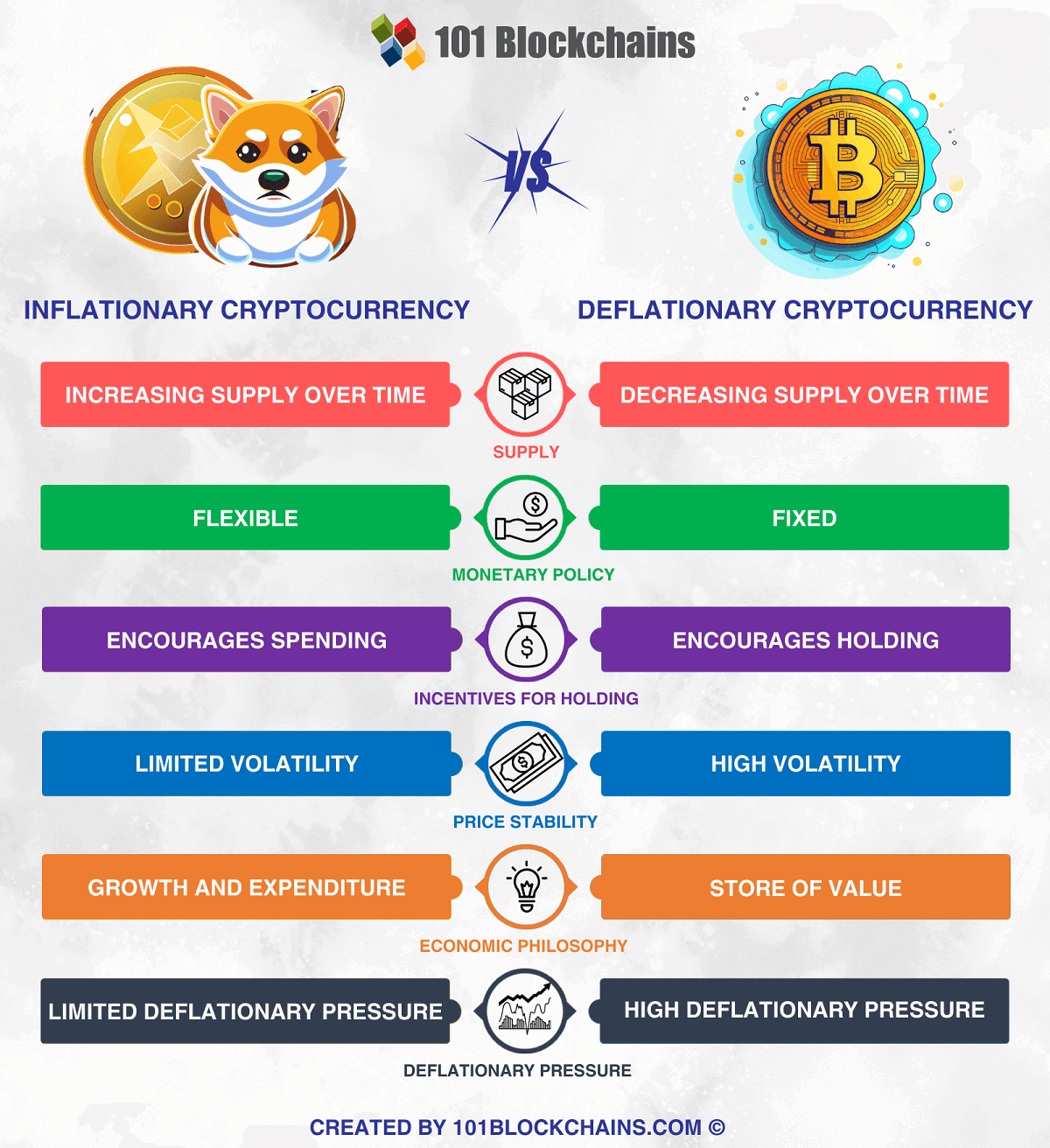Inflation vs Deflation Cryptocurrency: Key Differences

Cryptocurrencies are the most valuable and riskiest assets for investors in traditional markets. Many people are interested in adopting cryptocurrency as it promises higher returns compared to other assets. The inflation vs. deflation cryptocurrency debate has gained traction in the cryptocurrency space as people wonder about choosing the best cryptocurrency for investment.
The availability of different options between cryptocurrencies makes it difficult to make a final decision on investing in a particular cryptocurrency. What do inflation and deflation mean in the cryptocurrency world? Inflation refers to a phenomenon in which the purchasing power of money decreases over time, causing the prices of goods and services to rise. On the other hand, deflation refers to a phenomenon in which the purchasing power of money increases and prices fall over time.
The concept of inflation and deflation also applies in the cryptocurrency space. You can find inflationary and deflationary cryptocurrencies that follow the same patterns as the traditional financial environment. An inflationary cryptocurrency is one whose supply continues to increase over time.
This may lead to loss of value due to reduced scarcity. On the other end of the spectrum, deflationary cryptocurrencies are characterized by a decline in supply over time. Therefore, the scarcity of deflationary cryptocurrencies causes their value to rise. Let’s take a closer look at the differences between inflationary and deflationary cryptocurrencies.
Build your identity as a certified blockchain professional with 101 Blockchains’ blockchain certification, designed to provide enhanced career prospects.
What is an inflationary cryptocurrency?
The best way to tell the difference between deflationary and inflationary cryptocurrencies is to clearly understand their definitions. Additionally, in order to strengthen your understanding of inflation-type cryptocurrencies, you should also learn about the advantages of inflation-type cryptocurrencies.
Cryptocurrencies can be classified as inflationary as the supply of coins continues to increase over time. Inflationary cryptocurrencies combine predefined inflation rates, token distribution mechanisms, and supply constraints to maintain supply and incentivize participants.
Different cryptocurrencies have their own unique mechanisms for coin creation and market supply. Inflationary cryptocurrencies serve to gradually increase the supply of coins in the cryptocurrency market. Inflation and Deflation If you plan to work with cryptocurrencies, you should pay attention to the preset inflation rates.
The predetermined rate represents the percentage increase in the total supply of the cryptocurrency over time. Additionally, the maximum supply of an inflationary cryptocurrency is usually fixed or variable. After the maximum supply is reached, no more cryptocurrency can be minted.
It is important to note that not all inflationary cryptocurrencies have a fixed limit on their maximum supply. For example, Dogecoin had a maximum limit of 100 billion tokens. However, they removed the supply cap in 2014 and now there is an unlimited supply of DOGE tokens.
Do you want an in-depth understanding of cryptocurrency fundamentals, trading and investment strategies? Enroll now for our Cryptocurrency Fundamentals, Trading and Investing Course
Inflation Cryptocurrency Working Mechanism
Inflationary cryptocurrencies work by distributing newly minted tokens to network participants and utilizing a dedicated consensus mechanism. Consensus mechanisms play an important role in mining new coins or distributing existing tokens to network validators. For example, Bitcoin uses proof-of-work consensus where miners are rewarded for solving puzzles to verify transactions. On the other hand, the proof-of-stake consensus mechanism provides rewards to validators who verify the correctness of blocks.
The inflation vs. deflation cryptocurrency debate will also draw attention to cryptocurrency distribution through governance decisions. For example, a decentralized autonomous organization (DAO) can vote to release treasury funds, modify staking rewards, and set vesting periods. All of these factors can affect the inflation rate of a cryptocurrency along with the distribution of new coins.
Enroll in our Bitcoin Technology Course today to learn about Bitcoin mining and transactions and the information contained in blocks.
Examples of inflationary cryptocurrencies, pros and cons
Notable examples of inflationary cryptocurrencies include Bitcoin Cash, Ripple, and Dogecoin. For a comprehensive comparison with deflationary cryptocurrencies, we must also pay attention to the advantages of inflationary cryptocurrencies. The most notable advantage of inflationary cryptocurrencies for investors is the potential for reduced volatility due to greater supply. Additionally, the lack of scarcity reduces the risk of hyperdeflation. A larger token supply makes it easier to use in everyday transactions.
Inflation Cryptocurrencies also have some serious problems, including limited long-term price appreciation potential. Additionally, inflationary cryptocurrencies are less attractive to long-term investors looking to store value in cryptocurrencies. A larger token supply may also lead to disruptions in the form of higher devaluation and inflation risks.
I want to know about use cases for NFTs, DeFi, and cryptocurrencies in the metaverse. Enroll in our Cryptocurrency Basics Course now.
What is a deflationary cryptocurrency?
The next important player in the debate between inflationary and deflationary cryptocurrencies, namely deflationary cryptocurrencies, differs from their opponents in several ways. As the name suggests, deflationary cryptocurrencies experience deflation as their supply decreases over time. Deflationary tokens utilize various mechanisms to reduce supply. Common ways to reduce the supply of deflationary cryptocurrencies include burning coins or trading fees.
Deflationary cryptocurrencies follow a predefined deflation rate encoded in the protocol. The deflation rate helps determine the rate at which the total supply of a cryptocurrency decreases over time. For example, if the total supply of a cryptocurrency decreases by 2.5% per year, the annual deflation rate could be 2.5%. The answer to “What is the difference between an inflationary and a deflationary cryptocurrency?” also suggests that a deflationary cryptocurrency may have a variable or fixed maximum supply. Deflationary cryptocurrencies may have their maximum supply cap removed as needed.
One of the interesting details of deflationary cryptocurrencies is the fact that their economic aspects are not influenced by incentives for stakeholders. Stakeholders such as miners, users, and developers may have different goals and motivations that can affect the supply and demand of cryptocurrency. Miners can mine new coins and hold on to the newly mined tokens during a bull market instead of selling them. Likewise, removing supply limits could increase the risk of manipulation.
Embrace the technological leaps and global adoption that await in the upcoming 2024-2025 bull market with our Crypto Bull Run Ready Career Path.
Deflation Cryptocurrency Working Mechanism
The ideal approach to further advance the inflation vs. deflation debate for cryptocurrencies is to draw attention to the mechanisms at work. Deflationary cryptocurrencies may utilize indirect or direct mechanisms to destroy tokens in circulation. Some deflationary cryptocurrencies utilize transaction fees to encourage burning, which can reduce the total number of tokens in circulation.
Token burning may also involve the process of sending a certain amount of tokens to an inaccessible address. Deflationary cryptocurrencies also use other means to reduce token supply, such as halving. For example, we can look at Bitcoin’s halving mechanism to understand its role in reducing the supply of tokens.
Learn cryptocurrency terminology with free cryptocurrency flashcards.
Examples of the pros and cons of deflationary cryptocurrencies
Notable examples of deflationary cryptocurrencies include Bitcoin, Ethereum, and Polkadot. To understand why deflationary cryptocurrencies are better than inflationary cryptocurrencies, it is also important to understand the advantages of deflationary cryptocurrencies. Deflationary cryptocurrencies offer the best potential for long-term price appreciation due to increased capacity. It is also an ideal option for long-term investors looking for a reliable store of value. Additionally, deflationary cryptocurrencies have a lower risk of devaluation and inflation.
Deflationary cryptocurrencies also present some obstacles, such as scarcity due to limited token supply or hyper-deflation risk due to high volatility. A low token supply makes a deflationary cryptocurrency unsuitable for everyday transactions.
Start learning about cryptocurrency with the world’s first cryptocurrency technology path featuring high-quality resources tailored by industry experts!
What is the difference between inflationary and deflationary cryptocurrencies?
Inflation increases the token supply of a cryptocurrency, which helps drive more spending and increases network adaptability. On the other hand, deflation promotes scarcity and stores of value by reducing supply and increasing scarcity. Below is an overview of the differences between inflationary and deflationary cryptocurrencies, based on various important guidelines.
The supply of inflation-type cryptocurrencies increases over time, while the supply of deflation-type cryptocurrencies decreases over time.
Inflationary cryptocurrencies follow a flexible monetary policy, while deflationary cryptocurrencies follow a fixed monetary policy.
A notable advantage of inflationary cryptocurrencies is that they don’t incentivize holding, so you can spend more. On the other hand, deflationary cryptocurrencies reduce the supply of tokens in circulation and therefore encourage holding them.
Inflationary cryptocurrencies are less volatile, while deflationary cryptocurrencies are more volatile.
The economic goal of inflationary cryptocurrencies is to stimulate growth and spending. On the other hand, the advantage of deflationary cryptocurrencies is that they focus on the economic goal of being a store of value.
Inflationary cryptocurrencies experience limited deflationary pressures, while deflationary cryptocurrencies experience deflationary pressures due to their strength and scarcity.
Below is an overview of the differences between inflationary and deflationary cryptocurrencies.

final words
The answer to “What is the difference between an inflationary and a deflationary cryptocurrency?” shows that each variant has distinct advantages. At the same time, they also have unique challenges. The simplest way to understand the difference between the inflation and deflation cryptocurrency debate is the supply mechanism. The supply of an inflationary cryptocurrency increases over time, while the supply of a deflationary cryptocurrency decreases to encourage scarcity. Learn more about inflationary and deflationary cryptocurrencies to make the right choice.

*Disclaimer: This article should not be considered, and is not intended to provide, investment advice. The statements made in this article are not investment advice and should not be taken as such. 101 Blockchain is not responsible for any loss suffered by anyone relying on this document. Do your own research!



